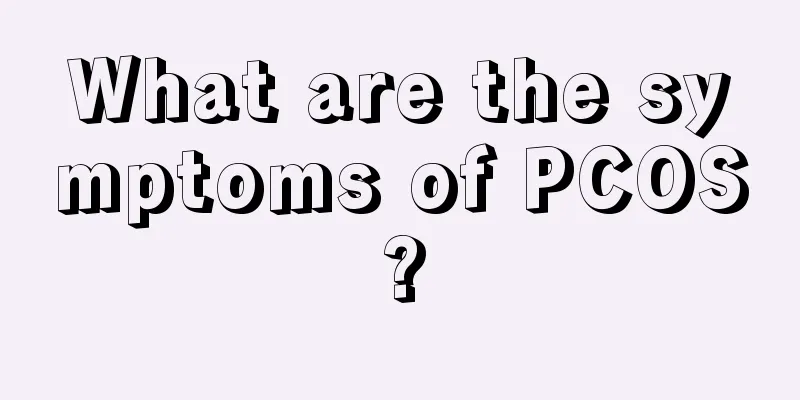What are the symptoms of PCOS?

|
A variety of diseases may occur in the human ovaries, including the well-known polycystic ovary syndrome. Under normal circumstances, a woman will only release one or a few follicles at a time, but some women have many follicles in their ovaries at the same time, so it is called polycystic ovary syndrome. This is a very harmful disease. Severe cases can cause infertility in female patients. In addition, patients will experience the following symptoms. What are the symptoms of PCOS? 1. Obesity: About half of the patients have this symptom, which is related to excessive androgen, increased proportion of unbound testosterone and long-term stimulation of estrogen. 2. Infertility: The main manifestations are anovulation or poor growth of the endometrium, which is not conducive to the implantation and development of the fertilized egg. 3. Hirsutism: such as thick eyebrows, increased hair on the upper lip, limbs, vulva and perianal area, or accompanied by masculinization phenomena such as acne and clitoral hypertrophy. 4. Increased waist circumference and abdominal mass: Patients notice that their clothes or belts seem tight and small, and when they press their abdomen, they find a mass inside, plus they experience abdominal distension and discomfort. 5. Abnormal menstruation and anovulation: The main manifestations are infrequent menstruation, scanty menstruation, amenorrhea, dysfunctional uterine bleeding, and amenorrhea. 6. Bilateral ovarian enlargement: Gynecological examination revealed that the bilateral ovaries were 1 to 3 times larger than normal and felt firm. Polycystic ovary examination items 1. B-ultrasound: It can be observed that the bilateral ovaries are symmetrically enlarged, and there are multiple small cysts in the ovaries, with different sizes and diameters of 2 to 6 mm, distributed around the ovarian cortex. 2. Laparoscopic examination: The ovaries on both sides are polycystic and enlarged, and the capsule is thickened and grayish white. This is one of the examination methods for polycystic ovary. 3. Hormone measurement: It can detect abnormalities in luteinizing hormone and follicle-stimulating hormone, low follicle-stimulating hormone, high luteinizing hormone, and increased androgen levels. 4. Endometrial biopsy: Endometrial biopsy performed before or during menstruation may reveal anovulatory proliferative endometrium or endometrial hyperplasia. This is also one of the methods for examining polycystic ovary. 5. Hysterosalpingography: observe the morphology and size of the ovaries and adrenal glands, and diagnose hyperandrogenism. |
<<: Causes of vulvar herpes in women
>>: What are the symptoms of menopause at 40?
Recommend
Five members of a family were diagnosed with the same cancer! Doctors remind us: Don’t put it off!
"If someone in the family has cancer, will t...
Ministry of Commerce: Nearly 42.2 million people applied for digital product purchase subsidies, driving sales of 66.95 billion yuan
The Ministry of Commerce issued the "Implemen...
Can I have a caesarean section at 36 weeks of pregnancy?
Generally speaking, it is not advisable for pregn...
Specific situation of fetal movement in 24 weeks of pregnancy
Pregnancy is a very difficult thing for women. Du...
Will I get pregnant if I have sex on the first day after my period?
Women are generally not likely to get pregnant if...
How to judge amniotic fluid leakage in late pregnancy
A woman will be pregnant at least once in her lif...
This is the truth about women’s aging!
Do you have routine gynecological examinations ev...
Do electric cars have any effect on the body? Why do people say that electric cars are harmful?
Recently there has been a saying on the Internet ...
Remedies for premature placenta
Premature placenta will affect fetal nutrition an...
When will Wu Xin: The Monster Killer Season 3 be broadcast? Will Yue Qiluo be in Wu Xin: The Monster Killer Season 3?
Looking at the trailers of various dramas on majo...
How to treat acne on the lower body?
The appearance of small pimples on your genitals ...
How to choose seats on high-speed trains during the epidemic? Which seats are the best for high-speed trains during the epidemic?
We all know that due to the impact of the new cor...
5 months pregnant belly bloating
The biggest change for women after pregnancy is t...
What to do if the vas deferens is painful
The male body produces new sperm continuously. Wh...
Does rectal effusion affect pregnancy?
I believe that everyone has a certain understandi...









